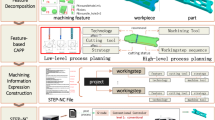Abstract
A technologically oriented tool selection and tool balancing system for milled components is presented. The system is capable of selecting the most economical tool set and, where necessary, adjusting the cutting conditions for all the features of a batch of components. Several key parts of the system such as the method for estimating the remaining tool life of a cutter used for selected different cuts, the cost equation used and the method of searching for the most economical tool set are discussed. The system has been used to analyse the tools required for the machining of a typical milled component. This analysis considered the influence of batch size, the number of repeat batches, the number of sister tools, inventory cost and of varying the cutting velocity within a given feature.
Similar content being viewed by others
References
R. Weill, G. Spur and W. Eversheim, “Survey of computer aided process planning systems”, Annals CIRP, 31(2), pp. 539–551, 1982.
W. Eversheim and J. Schulz, “Survey of computer aided process planning systems”, Proceedings of the 1st CIRP Working Seminar on Computer Aided Process Planning, Paris, pp. 1–8, 1985.
R. A. Wysk, “Automated process planning systems — an overview of ten years of activities”, Proceedings of the 1st CIRP Working Siminar on Computer Aided Process Planning, Paris, pp. 13–18, 1985.
I. Ham “CAPP: present and future”, CIRP keynote paper, Annals CIRP, 37(2), pp. 591–601, 1988.
L. Alting and H. Zhang, “Computer aided process planning: the state-of-the-art survey”, International Journal of Production Research, 27(4), pp. 553–585, 1989.
H. A. ElMaraghy, “Evolution and future perspectives of CAPP”, Annals CIRP, 42(2), pp. 739–751, 1993.
F. Giusti, “COATS: an expert module for optimal tool selection”, Annals CIRP, 38(1), pp. 337–340, 1986.
R. Melkote and D. L. Taylor, “Implementation of rule based selection of milling cutters, feed rate and spindle speed”, Proceedings of the Conference on Computers in Engineering, San Francisco, USA, pp. 427–432, 1–4 August 1988, ASME, New York, 1988.
F. J. A. M. van Houten, “PART: selection of machining methods and tools”, 22nd CIRP International Seminar on Manufacturing Systems, Enschede, pp. 1–16, 11–12 June 1990.
H. M. Rho, R. Geelink, A. H. van't Erve and H. J. J. Kals, “An integrated cutting tool selection and operation sequencing method”, Annals CIRP, 41(1), pp. 517–520, 1992.
R. M. Boogert, “Tool management in computer aided process planning”, PhD thesis, University of Twente, 1994.
B. Gopalakrishnan, “Machine parameter selection and cost estimation techniques: applications in concurrent engineering”, Proceedings of Manufacturing International 1992, Manufacturing International '92, ASME 1992, Dallas, Texas, 29 March–1 April 1992.
T. C. Chang, Expert Process Planning for Manufacturing, Addison-Wesley, Reading, 1990.
F. Ju, “Economic tool selection and tool management for milled components”, Ph.D. thesis, UMIST, UK, 1997.
T. L. Lau, “Optimisation of milling condition”, PhD thesis, UMIST, Manchester, UK, 1987.
R. Enparantza, “Tool selection and cutting conditions optimisation in milling”, PhD thesis, UMIST, UK, 1991.
Yong-sheng, Ma, “The automation of tool path generation in milling”, PhD thesis, UMIST, 1994.
F. Ju and G. Barrow, “Influence of tool inventory cost on tool selection and tool balancing for milling operations, part 1: the estimation of remaining tool life”, 32nd International MATADOR Conference, UMIST, UK, pp. 501–506, July 1997.
C. Berliner and J. A. Brimson, Cost Management: for Today's Advanced Manufacturing, Harvard Business School Press, Boston, MA, 1988.
F. Ju and G. Barrow, “Influence of tool inventory cost on tool selection and tool balancing for milling operations, Part 2: the economic evaluation of selected tool sets”, 32nd International MATADOR Conference, UMIST, UK, pp. 507–512, July 1997.
J. H. Zhang, “Automatic tool set selection for batch production of turned components”, PhD thesis, UMIST, Manchester, UK, 1994.
C. Koulamas and E. Iakovou, “Machining economics with machine interference considerations”, International Journal of Production Research, 33(1), pp. 71–78, 1995.
Author information
Authors and Affiliations
Corresponding author
Rights and permissions
About this article
Cite this article
Ju, F., Barrow, G. A technologically oriented approach for the economic tool selection and tool balancing of milled components. Int J Adv Manuf Technol 14, 307–320 (1998). https://doi.org/10.1007/BF01178909
Issue Date:
DOI: https://doi.org/10.1007/BF01178909



